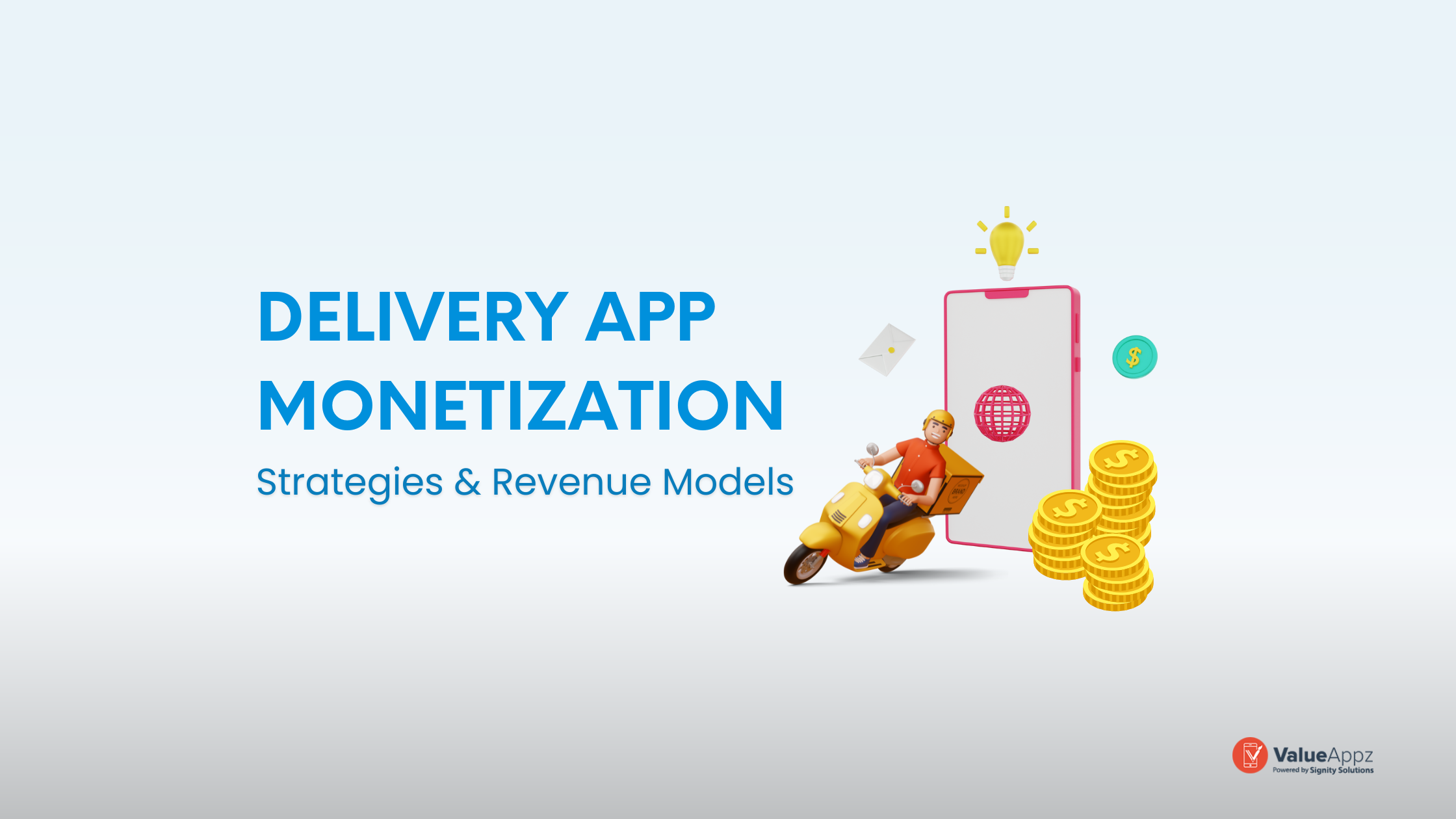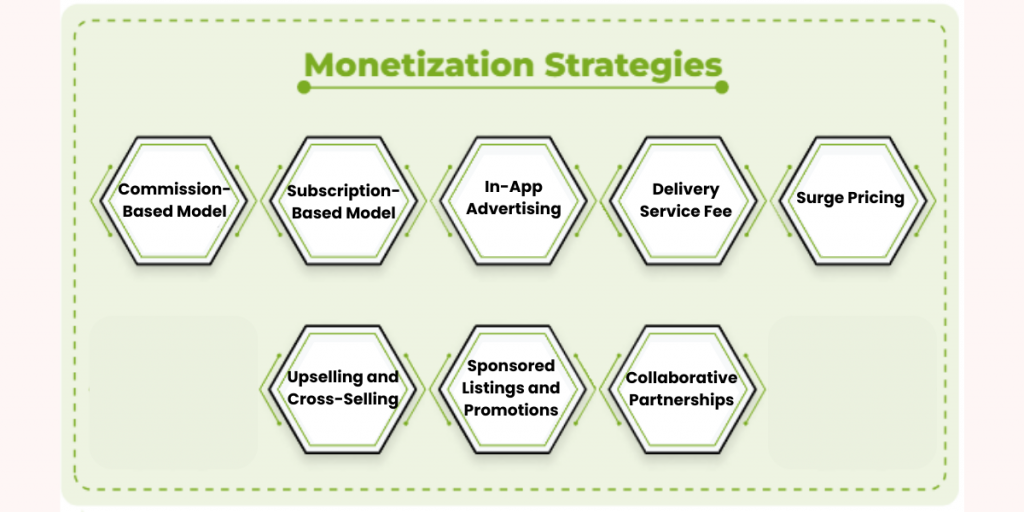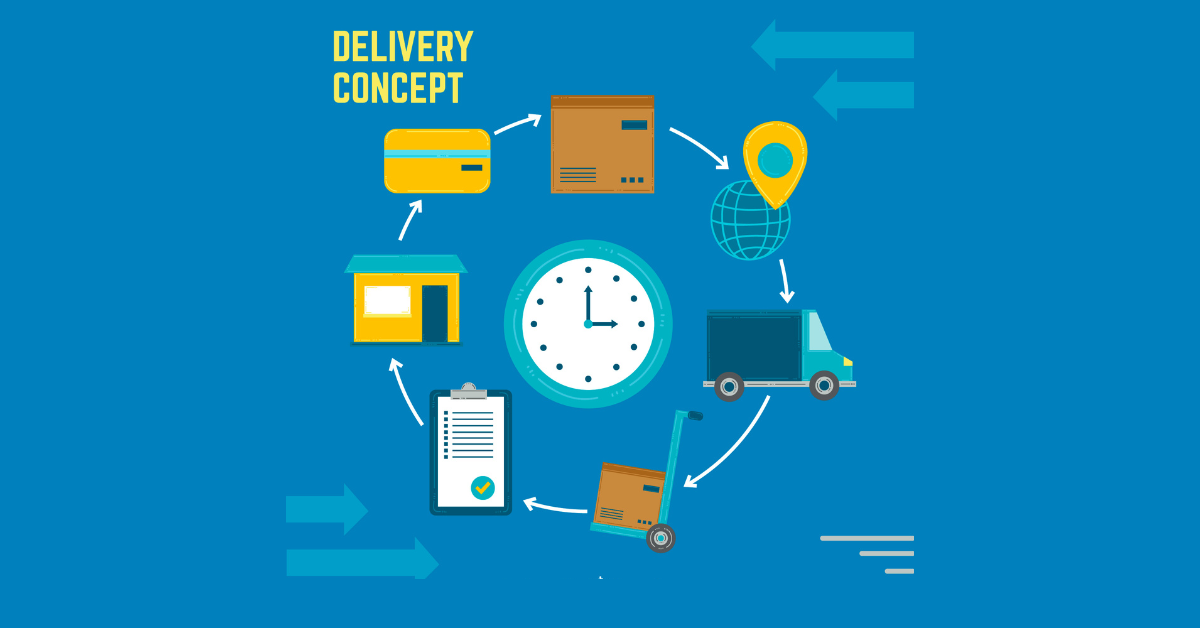How to Monetize Your Delivery App: Revenue Models and Strategies

Quick Summary: Though on-demand delivery apps have become popular and a necessity, have you ever thought about how they make money? How are apps like Uber Eats, TaskRabbit, Instacart, and other leading brands able to generate profits? This blog will guide you on the delivery app monetization methods and strategies to ensure you get the desired ROI.
Do you own an on-demand delivery app? What methods do you use to generate revenue from the app? Did you know that the top on-demand delivery apps use multiple revenue models to earn profits?
If you are a startup willing to enter the on-demand delivery industry, answering these questions is crucial to understanding the revenue models. On the other hand, if you are already in the market, are you using all the right strategies?
On-demand delivery apps can make more money by using revenue models, which offer systematic ways to commercialize their offerings. With these models, apps can now make money in various ways, including commission-based fees, subscription plans, in-app advertising, delivery service fees, surge pricing, upselling, cross-selling, sponsored listings, promotions, and so on.
Further, these apps can tap into many revenue streams, diversify their money sources, and enhance their earning potential by incorporating the right revenue models. It guarantees the app’s financial viability and makes it possible to invest in technological developments, increase the number of users, improve the customer experience, and keep a competitive advantage in the market.
Key Takeaways
- Successful on-demand delivery apps often use multiple revenue models such as commission-based, subscription-based, in-app advertising, delivery service fees, surge pricing, etc.
- Some of the most widely used revenue models include subscription-based, surge pricing, and in-app advertising.
- Upselling and cross-selling models have led to higher sales in the on-demand delivery apps that use these.
- Using revenue strategies based on user data can help brands acquire better and higher profits.
- Startups can initially use just one revenue model and add more as the business grows.
How do delivery businesses make money? As mentioned above, they use several revenue models like advertising, delivery fee, surge pricing, and more. Want to know more? Keep reading the blog to learn in detail about delivery app monetization strategies and start earning profits.
Table of Contents
Top Delivery App Monetization Models and Strategies
Whatever industry your business may belong to, the following delivery app monetization models and strategies will help you get better Returns on Investment and boost sales and profits.

1.Commission-Based Model
One of the most popular delivery app monetization models is the commission-based model. It helps businesses earn revenue by charging a percentage of each order that is placed through the app. In this revenue model, the app collaborates with nearby merchants like restaurants, grocers, or retailers in exchange for a commission on each transaction made possible by the app. The app takes a percentage of the order value as a commission when a customer orders through the app.
The model is advantageous to the app and the affiliated companies. The software is a platform that links users with nearby businesses, providing them with the ease of online ordering and delivery. By imposing a fee, the app generates income based on the quantity and cost of transactions carried out on its platform.
For example- Uber Eats charges a commission of 15%-30% depending upon the plan the service provider chooses.
💡 How to build an on-demand delivery app. Here is A Complete Guide On Building Your On-Demand Delivery App
2. Subscription-Based Model
The subscription-based model is another commonly used revenue model in the on-demand delivery industry. In this model, the app provides users with a variety of subscription plans, usually with monthly or yearly billing cycles. To enjoy the app’s exclusive features and privileges, subscribers pay a recurring subscription.
A subscription-based business strategy encourages consumers to sign up by giving them access to benefits like free or discounted delivery, priority time slots, tailored suggestions, or exclusive pricing. For subscribers, these advantages add value and motivate them to use the app for their delivery requirements. The regular subscription payments offer the app a steady cash stream, helping in both the growth and operation of the company.
For example, Instacart provides Instacart at a $99/year fee or $9.99/month. The members can enjoy unlimited free delivery on all orders above $35 with other benefits.
3. In-App Advertising
On-demand delivery apps frequently use in-app advertising as a revenue stream. This approach uses the app’s UI to display adverts to make money. The delivery app may contain banner adverts, popup ads, or sponsored content that has been put strategically.
The on-demand delivery software also takes advantage of its user base and high consumer engagement to offer advertising options by collaborating with businesses and advertisers. By purchasing ad spaces within the app, advertisers can reach a specific group of users already actively using the app’s features. The app can employ a variety of targeting strategies, such as user preferences or demographic information, to display relevant and tailored adverts, boosting conversion rates and generating income.
For example- DoorDash lets the service providers run ads to reach more customers and drive better sales. With built-in marketing tools, brands can easily advertise.
💡 Are you a startup looking to invest in on-demand delivery apps? Check out the blog- Why Is It The Best Time To Invest In On-Demand Delivery Apps?
4. Delivery Service Fee
On-demand ordering and delivery apps frequently use the delivery service fee as a business strategy. The app bills users for each delivery made using its platform in this business model. The revenue from this fee goes toward maintaining the app. It is included in the total price of the order.
The delivery service fee is put in place to pay for the administrative expenses related to offering delivery services. It covers costs like paying drivers, managing logistics, providing customer service, and upkeep for the app infrastructure. The clients who profit from the ease and effectiveness of the delivery service can directly fund the app by paying a different fee for each delivery.
For example- Blinkit charges rupees 9 for orders below 500 and rupees 30 during the peak hour.
5. Surge Pricing
On-demand delivery applications frequently use surge pricing as a revenue model to increase profits during high-demand or low-supply times. In order to profit from the increased demand and encourage the availability of more drivers or delivery partners, it entails temporarily raising the prices of services or goods.
Surge pricing enables the app to dynamically alter rates based on the current market conditions during peak hours, special events, or when demand exceeds supply. Algorithms and real-time data analysis are frequently used in the surge pricing mechanism to choose the right surge multiplier to add to the base price. This surge multiplier may change depending on variables, including the moment, the place, and the demand patterns.
For example- Uber has clearly explained its surge pricing model. It tends to increase the prices during high demands.
💡 Must check: Best Practices And Design Tips For On-Demand Delivery App Development
6. Upselling and Cross-Selling
Upselling is the practice of convincing buyers to purchase more expensive or upgraded versions of the goods or services they have already purchased. Studies have shown that upselling enhances revenue by 10%-30% on average.
For instance, the app can recommend extra toppings, sides, or drinks when a consumer adds a pizza to their cart to improve their eating experience. The app allows customers to add more goods to their order, raising the order value and generating more income by displaying these possibilities throughout the checkout process.
In contrast, cross-selling entails advising buyers on similar or complementary goods and services.
For instance, if a consumer orders a burger, the app might recommend a combo offer that includes fries and a soft drink. The software increases the likelihood that customers will add more things to their order, resulting in more income, by highlighting these supplementary items that go well with the initial order.
7. Sponsored Listings and Promotions
Another popular delivery app monetization model is sponsored listings and promotions. By purchasing sponsored listings, businesses can gain a more prominent position in the app’s search results or category listings. Enterprises benefit from greater exposure because it makes them stand out from competitors and enhances customers’ likelihood of buying their products and services.
Brands that pay for sponsored listings can successfully market their products or services to a specific target audience, increasing brand awareness and possibly generating more sales.
Businesses can offer exclusive offers or discounts to app users through promotions within the app. It can include one-time bargains, special discounts, or packages. By providing these promos, companies may improve their clientele, boost sales, and forge a win-win partnership with the on-demand delivery app.
Companies receive improved visibility and prospects for customer acquisition, and the app profits from the extra cash provided by sponsored promotions.
For example- A sponsored listing for a furniture assembly task in San Francisco might cost around $10 per day, while a sponsored listing for a dog walking task in New York City might cost about $20 per day.
💡 What is the cost of building an on-demand delivery app? Read the blog: On-Demand Delivery App Development Cost In 2023
8. Collaborative Partnerships
On-demand delivery applications leverage collaborative partnerships as a revenue model to broaden their user base, increase user engagement, and increase income by strategically partnering with other companies or platforms. In this strategy, the delivery app collaborates with complementing platforms or services to build a connection that benefits both parties.
Further, these apps can access new markets through collaborative collaborations, boost brand awareness, and enhance transaction volume. The app can increase its revenue potential while giving consumers a more thorough and smooth experience by utilizing the strengths and clientele of partnered companies or platforms.
For example- DoorDash announced a partnership between DoorDash and CVS Health to provide on-demand delivery of prescription drugs from CVS Pharmacy locations was announced in 2022. Through this alliance, CVS Health was able to connect with a new group of clients who were looking for frictionless and convenient prescription medicine delivery. DoorDash broadened its customer base by entering the pharmaceutical business and providing a greater selection of goods.
Build an On-Demand Delivery App and Start Earning Profits
Now that you know about the top delivery app monetization models, you must understand that it is a highly-profitable business. Not just it helps earn money, but it also helps take products and services online across a wider audience.
Therefore, you need an on-demand delivery app for your business growth. ValueAppz is a leading on-demand delivery app development company helping startups, small businesses, and enterprises across all industries. Our expertise and readymade apps will help you quickly launch in the market.
Contact us now and build your online business to enhance the ROI.
Frequently Asked Questions:
Q1. How can I improve my app monetization?
Understanding your target demographic and the market as a whole, as well as the competition and the potential profitability of different revenue models, are crucial for improving app monetization.
Q2. How do you create a monetization strategy?
Understanding your target market and audience, assessing the competition, and examining the potential profitability of various revenue models are necessary to develop a monetization plan.
Q3. What is an example of a monetization strategy?
A commission-based strategy, where a percentage of each transaction is charged for using the app, is a usual example of delivery app monetization.
Q4. How do apps get monetized?
Apps can be monetized through various revenue models, such as commission-based, subscription-based, advertising-based, delivery fee, white label solution, service provider fee, in-app purchases, sponsored listings, data monetization, and affiliate marketing.
Q5. How much does a mobile app development cost for an on-demand delivery app?
On average, the on-demand delivery app development can cost between $15,000-$60,000. It can further vary based on the platforms, number of features, app complexity, etc.
THE AUTHOR
Mohit Yadav
As an expert in Digital Marketing, I always look forward to keeping up with the latest trends and customers’ changing demands. Hence, I focus on content that updates the readers in-depth about the industry.

Get ready to digitally transform your business.
Let our team help take your business to the next level. Contact us today to get started on finding the perfect solutions for your business needs.







